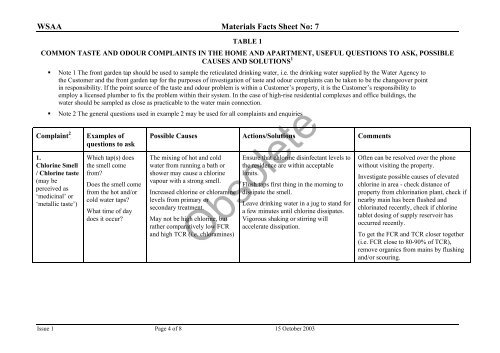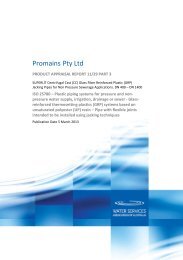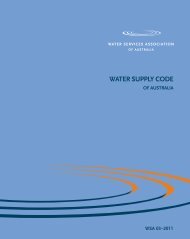Fact Sheet 7 Investigating Taste and Odour Complaints
Fact Sheet 7 Investigating Taste and Odour Complaints
Fact Sheet 7 Investigating Taste and Odour Complaints
You also want an ePaper? Increase the reach of your titles
YUMPU automatically turns print PDFs into web optimized ePapers that Google loves.
WSAA Materials <strong>Fact</strong>s <strong>Sheet</strong> No: 7<br />
TABLE 1<br />
COMMON TASTE AND ODOUR COMPLAINTS IN THE HOME AND APARTMENT, USEFUL QUESTIONS TO ASK, POSSIBLE<br />
CAUSES AND SOLUTIONS 1<br />
Note 1 The front garden tap should be used to sample the reticulated drinking water, i.e. the drinking water supplied by the Water Agency to<br />
the Customer <strong>and</strong> the front garden tap for the purposes of investigation of taste <strong>and</strong> odour complaints can be taken to be the changeover point<br />
in responsibility. If the point source of the taste <strong>and</strong> odour problem is within a Customer’s property, it is the Customer’s responsibility to<br />
employ a licensed plumber to fix the problem within their system. In the case of high-rise residential complexes <strong>and</strong> office buildings, the<br />
water should be sampled as close as practicable to the water main connection.<br />
Note 2 The general questions used in example 2 may be used for all complaints <strong>and</strong> enquiries<br />
Complaint 2<br />
1.<br />
Chlorine Smell<br />
/ Chlorine taste<br />
(may be<br />
perceived as<br />
‘medicinal’ or<br />
‘metallic taste’)<br />
Examples of<br />
questions to ask<br />
Which tap(s) does<br />
the smell come<br />
from?<br />
Does the smell come<br />
from the hot <strong>and</strong>/or<br />
cold water taps?<br />
What time of day<br />
does it occur?<br />
Possible Causes Actions/Solutions Comments<br />
The mixing of hot <strong>and</strong> cold<br />
water from running a bath or<br />
shower may cause a chlorine<br />
vapour with a strong smell.<br />
Increased chlorine or chloramine<br />
levels from primary or<br />
secondary treatment.<br />
May not be high chlorine, but<br />
rather comparatively low FCR<br />
<strong>and</strong> high TCR (i.e. chloramines)<br />
Ensure that chlorine disinfectant levels to<br />
the residence are within acceptable<br />
limits.<br />
Flush taps first thing in the morning to<br />
dissipate the smell.<br />
Leave drinking water in a jug to st<strong>and</strong> for<br />
a few minutes until chlorine dissipates.<br />
Vigorous shaking or stirring will<br />
accelerate dissipation.<br />
Obsolete<br />
Issue 1 Page 4 of 8 15 October 2003<br />
Often can be resolved over the phone<br />
without visiting the property.<br />
Investigate possible causes of elevated<br />
chlorine in area - check distance of<br />
property from chlorination plant, check if<br />
nearby main has been flushed <strong>and</strong><br />
chlorinated recently, check if chlorine<br />
tablet dosing of supply reservoir has<br />
occurred recently.<br />
To get the FCR <strong>and</strong> TCR closer together<br />
(i.e. FCR close to 80-90% of TCR),<br />
remove organics from mains by flushing<br />
<strong>and</strong>/or scouring.






